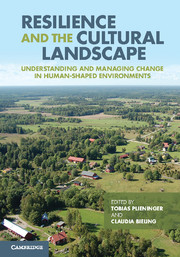 Resilience and the Cultural Landscape
Resilience and the Cultural Landscape Book contents
- Frontmatter
- Contents
- List of contributors
- Preface
- Part I Conceptualising landscapes as social–ecological systems
- Part II Analysing landscape resilience
- Part III Managing landscapes for resilience
- 12 Collective efforts to manage cultural landscapes for resilience
- 13 Response strategy assessment: a tool for evaluating resilience for the management of social–ecological systems
- 14 Ecosystem services and social–ecological resilience in transhumance cultural landscapes: learning from the past, looking for a future
- 15 The role of homegardens in strengthening social–ecological resilience: case studies from Cuba and Austria
- 16 Promises and pitfalls of adaptive management in resilience thinking: the lens of political ecology
- Part IV Perspectives for resilient landscapes
- Index
- References
12 - Collective efforts to manage cultural landscapes for resilience
Published online by Cambridge University Press: 05 November 2012
- Frontmatter
- Contents
- List of contributors
- Preface
- Part I Conceptualising landscapes as social–ecological systems
- Part II Analysing landscape resilience
- Part III Managing landscapes for resilience
- 12 Collective efforts to manage cultural landscapes for resilience
- 13 Response strategy assessment: a tool for evaluating resilience for the management of social–ecological systems
- 14 Ecosystem services and social–ecological resilience in transhumance cultural landscapes: learning from the past, looking for a future
- 15 The role of homegardens in strengthening social–ecological resilience: case studies from Cuba and Austria
- 16 Promises and pitfalls of adaptive management in resilience thinking: the lens of political ecology
- Part IV Perspectives for resilient landscapes
- Index
- References
Summary
Introduction
European landscapes have a long history of being used by humans. This has led to the development of valuable habitats, some of which depend on the continuation of a certain type of use or require active management (e.g. fruit orchards, mountain meadows, upland moorlands). Society and policy makers have recognised the need to support the management of cultural landscapes, based on the rationale to maintain attractive landscapes for tourism and recreation, to protect habitat for wildlife, to enhance the provision of ecosystem services or to counteract demographic change and keep people in rural areas.
Support policies often take the shape of incentive schemes, conservation projects or rural development initiatives. In many countries, habitat and biodiversity strategies and programmes exist. It is unlikely that agencies and government authorities have the capacity and resources to undertake all required management. The successful planning, coordination, implementation and monitoring of management activities in cultural landscapes require communication and cooperation. Coordinated action is necessary between different stakeholders from different sectors but there also needs to be coordination between different institutional levels. This has been referred to as the ‘cross-scale interplay of institutions [which] involves horizontal and vertical linkages’ (Berkes, 2004). Multi-stakeholder partnerships and collaborative groups can play an important role in facilitating these linkages.
- Type
- Chapter
- Information
- Resilience and the Cultural LandscapeUnderstanding and Managing Change in Human-Shaped Environments, pp. 205 - 223Publisher: Cambridge University PressPrint publication year: 2012
References
- 2
- Cited by


